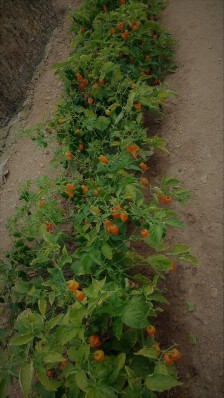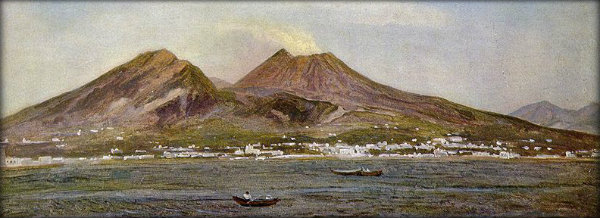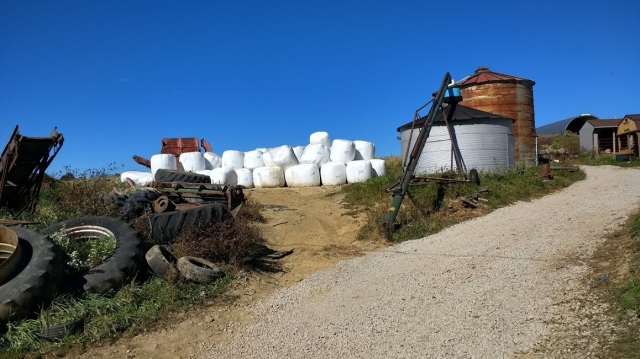A short presentation to answer the pressing question.
What is Organic
A short presentation to answer the pressing question.
What is Organic
 Farmers’ Almanack
Farmers’ Almanack
Seeds in upward opposition,
Pilot hurdles sound and steady.
Knowledge lets some harden.
Hoed rows shape this garden.
Wherewithal yells field ready,
Harvest sought at destination.
poem by wooleylot
When the volcano erupted, most people fled to where they felt safe, although they were actually running towards the volcano.

Preparation has begun for another run of “Fire on the Mountain“. It’s a home-made spicy hot mustard. When someone really wants to get away from a dangerous situation as fast as they can, they usually “run for the hills“, assuming higher ground is safer. This is not always the case. A long period of calm usually means an eruption may happen soon.
Part of the organic inspector’s duties is to do farm visits. This year, I visited several organic dairy farms located in Somerset county, of southwestern Pennsylvania. And on one of these farm visits, I encountered a first-time experience hearing about what could be called paranormal activity. The farmer’s story went something like this. We have had some unexplained activity in the calf hutch area, that just started earlier this week. We set up our calf hutches, and when we returned we found that the pen fencing panels were moved, and the door latches on the hatches were unlatched and the doors were opened. No one had been around the area to do this, so we are not sure what is happening to do this. We have since tied the latches with strings, to keep them closed. This area, was recently cleared of some old unused farm equipment that had accumulated over the years. Once cleared and cleaned up, it made a nice area for the placement of the calf hatches. So, because of the reoccurring activity, we did some research at the local historical society, and found out that this is a very old farm, and the original farmstead dated back to early 1800’s. At that time, it was not uncommon for the families to have their own private burial plot. And, this calf housing area was once a family burial plot. The records showed that the tombstones were all removed many years ago, but the old graves were not moved. So, we cleared the area on September 30th, 2017, and set up the calf hutches. The records showed that one of burials was on September 30th, 1830.

Could it be that the unexplained activity was the work of restless spirits from the old burial site? My job as an inspector was to assess the potential injury risk to the livestock. My conclusion was that the unexplained activity seemed more like mischievous pranking, at worst and didn’t appear to be meant as harmful in it’s nature. So, it wasn’t an issue of concern.
This farmer’s story prompted me to do some of my own research. Let us dash to an earlier time, occurring not long ago; in fact, just a brief journey not much more than 200 years ago. And interestingly this nearby juncture, when measured as a trip in mileage, is just over 200 miles away from the nowadays abode. It was then and there, that Elizabeth (Betsy) Leichliter was born on the 14th day of June in 1813 in Somerset County, Pennsylvania and was the first daughter born to Jacob Leichliter. Daniel Williams was born about then, however a few years earlier, on the 12th day November in the year 1803 in Upper Turkeyfoot, Somerset, Pennsylvania. And, destiny came to intervene, and they were married on the 31st day of March in 1831. And, to them were born eleven children as blessings of this union.
Their last child, Levi Campbell Williams of Upper Turkeyfoot, Somerset grew to be a young man, and married Druscila B Koontz and they had children born to them.
A line of descent traces to a grandfather on mother’s side, George E Williams born April of 1892 in Somerset County. And this relationship goes back to a place, where the farms of rolling fields adjoin the forests, called the Williams-Firestone Cemetery located along the Hexie Road, that whispers distance echoes from a quiet hillside in Upper Turkeyfoot Township, Somerset, Pennsylvania.
Going further, “John Leichliter was the first family to arrive in Somerset County, Pennsylvania. He married Lydia Green in 1784. They had children: Jacob, David, John, Sarah, Margaret and Samuel. John died at the home of his son Jacob in the Hexeborger Hills. His burial place is unknown.
Jacob Leichliter was born August 11th, 1788. John, his father, located in “Jersey” of Somerset County, then a dense forest, and endured hardships and privation at the beginning. Robert Hare, nearest neighbor a mile a-way. Often relieved wants of the then little family. Jacob was then a little child, crying for a morsel of corn-bread with no other drink than water. Hare’s kindly sent milk, soon a cow was brought home.
Jacob grew with sterling qualities, marrying Jemima Campbell about 1812, to whom were born sons; R. Campbell, Thomas, John, Levi and Samuel C.; Elizabeth, married Daniel Williams; Mary A. to Jacob Crossen; Lydia died young. The two eldest sons died young. John and Levi were ministers. Mr. Jacob Leichliter was father of 19 children, some born in this county where nearly all the family have made their home.”
Sources: http://www.lichliter.com/Mountaineer.htm
http://www.lichliter.com/Early_History.htm
The precise grave site for John Leichliter remains unknown to this day and most likely still lays somewhere in that previously dense primeval forest once known as the Jersey of Hexeborger Hills but now is known as Somerset, Pennsylvania.
My own research showed that I indeed have family roots in Somerset County. The old Williams-Firestone Cemetery is located along the Hexie Road, and it is a private cemetery, not all that much different than the one that was discovered at the farm. The tombstones are in bad condition, but still mark this location though.
http://www.usgwarchives.net/pa/somerset/cemeteries/594.htm
I must admit, that I did have a bit of that feeling of déjà vu while on assignment in Somerset County. It was a very fascinating phenomenon. It can only described as a slightly eerie feeling, but was not scary in any way, and simply put a moment of not being unable to fully differentiate the past from reality.
We are grateful for the time that we were given to visit in these old farmlands that in many cases are being restored into productive fields that have already given us so much bounty.
Greetings from the primitive ploughman. Annabelle and Lola checking the garlic in the fields on the Wooleylot Farm. We are fully committed to upholding fine traditional cultural practices to maintain our organic integrity. Dogs on-guard duty for any round-up sprayers with orders to bite them in the arse.
On rare occasion, we are lucky enough to find that “one in a million” type like this unusually shaped King Harry potato. Do you think that it has grown into an odd shape or does he resemble a valentine heart? It all in the eye of the beholder that gets to decide what is beautiful.
The Fall 2016 issue of The Inspectors’ Report has an article of local interest on page 19. It tells of the accounts and insights from a real-life USDA organic inspector. With first-hand knowledge of the narrative, the article is reprinted here for our blog readers.
The IOIA Inspector’s Report Volume 25 – Number 4 – Fall 2016
Last spring, I attended the International Organic Inspectors Association (IOIA) Organic Crop Inspection training held at Deer Creek Lodge and Conference Center in Mt. Sterling, Ohio. You might have read about this in the spring edition (Volume 25 – Number 2) of the IOIA Inspector’s Report [1]. This article is a follow-up to that article and chronicles the story line from the course completion to the point of performing farm inspections on my own.
Once one completes the IOIA Basic Crops training course, the next task at hand is the Mentored Organic Inspector Apprenticeship. Anyone who is thinking about an apprenticeship should keep in mind a few important things. First, the inspectors who have enough experience to be good mentors are probably very busy with their own inspection assignments. So, even though they might want to help, they can’t always do so. There is definitely a need to be patience and understand that if someone isn’t able to help mentor you right way; it’s probably because of constraints beyond their control. With that said, I must say that for me, it took longer than I had hoped. But, after having applied a little bit of patience, it did happen.
My apprenticeship consisted of four mentored inspections. The first two were in mid-September. Two different inspectors were shadowed on these inspections for a look at variety of techniques. These first shadowing inspections were filled with awe and admiration at seeing the inspectors perform their work. So here, my role as the apprentice was only to watch and learn. On my third mentored inspection, I was given the seed search verification and crop audit tasks to do at the inspection, which I managed to handle satisfactory. In fact, it felt good to actually contribute something to help my mentor.
And finally that day came in the second week of October; my first inspection shadowed by the mentoring inspector. As it turned out my first inspection was a new client (not usually done but time was of the essence) who was requesting certification of 180 acres of hay and pasture. I said a short prayer, “Please God, don’t let me screw this up!” My prayers were answered, and I was given the go ahead to start inspecting on my own. My mentor gave me the following recommend: “The reports you submitted to me are very thorough in fact I hope I am not held to that standard. I would recommend that you are more than capable to carry out solo inspections.”
Ok, so it wasn’t so much just hope and prayer that got me though this. My IOIA training gave me the sturdy foundation that I needed to have a basic grasp of the task at hand. The accumulation of knowledge gained from the abundance of class work, homework assignments and exercises administrated at the IOIA training played a large part in this success. My mentor’s tutoring came in very useful, too. The mentor’s recommendation to make it a practice to review the Materials Used Form for inputs that are allowed with restrictions and then to check during inspection that all of those restrictions are being followed and documented appropriately was most helpful.
Just so you know everything did not go perfectly smooth. So, the basic plan that day was to meet with my mentor ahead of time, about one-half hour before the scheduled inspection time so that we could drive to the farm together. Inspection start time was scheduled at 8 am, and the meet-up time was to be about 7:30; so that put us both on the road starting out around 5 that morning. In Pennsylvania, we have a whitetail deer population. And as it so happened, my first inspection date aligned precisely with the start of the deer’s rutting season. This means that the deer are especially active, and are prone to cross the highway at all times of the day or night. So as you might have already guessed, my mentoring inspector hit a deer driving to the inspection. Yup, he had to go back home to “inspect” for damage before continuing. So needless to say we arrived to the inspection about an hour late. And so, this serves as example of what can go wrong in this sort of line of work. The good news is that the farmer applicant was on his way to growing organic hay this year, and plans to transition to an organic dairy next year.
After the apprenticeship, I earned the “allowed to do inspections on my own” status. This was truly good and well worth the wait and time spent, I felt. For one thing, I can schedule my farm visits as I wish and go directly to the farms without having to coordinate with a mentoring inspector. My plan to start was straightforward and simple – begin with a couple of nearby hay and pasture farms in order to wring out my techniques and hone my inspector skills.
As fate would have it, that idea didn’t go as planned. My first solo inspection came in as an Urgent Inspection Request from a 400 acre Corn, Soybean and Small Grain farmer who had added a few acres of corn, some of which had been harvested and kept segregated on a wagon. The farmer was not able to continue harvesting until the review of the inspection report. Right of the bat, it was baptism by fire, so to say. In spite of this, I was able to satisfactory complete the assignment and provide the inspection report in a timely manner. The mock farm inspection during the IOIA training hit the mark as the wheat, corn and soybeans production on that teaching exercise prepared me well for that of the farm that needed the urgent inspection.
In hind sight, the Urgent Inspection Request was probably the best learning experience one could have. After that, the remaining assignments didn’t look all that difficult. But as I soon learned, each farm had a particular element of uniqueness and every one required special attention to the details during the inspection process. And in that way, this added to the appeal of the job as I realized that no two inspections will ever be exactly the same. Each one, you see is truly a unique experience. So with that being the case, this is where I will end, after having successfully completed twelve solo inspections in my first year of being an organic inspector.
[1] IOIA Inspector’s Report (Volume 25 – Number 2) page 16
We are pleased to announce that our organic inspector apprenticeship is now complete. We are experiencing that fine feeling called satisfaction of achievement or maybe as it was once said of having that know-how training “under one’s belt”.
Our mentoring inspector reports back; “The reports you submitted to me are very thorough in fact I hope I am not held to that standard. I would recommend that you are more than capable to carry out solo inspections.” We have to say that this good result was in large part due to the excellent tutoring provided by both of the mentoring inspectors that guided us during the training period.
So with that done, we are scheduling inspections at the rate of 5 or 6 per week, so as to complete the amount assigned by the requested completion date.
The fall rains are upon us, and what has been the droughty Freeman Run with a barely flowing trickle of water all summer-long is now about to flood its banks; and so a good time to talk some about rubber boots. We in Potter County, Pennsylvania certainly know about mud. So, here goes one farmer’s opinion.
My Muck Chore boots have all but fallen apart. So, it’s time to break in some new rain boots. Now about Muck, in my opinion; those boots <insert a word the rhythms with muck here>. They were heavy and clunky, and the neoprene material was very stiff and prone to cracking. Ok, they are a few years ago, but they began to breakdown too quickly, and leaked soon after they were put into service.
In fact, being so dissatisfied with having wet feet for way too long thanks to those “ugly Mucklings“, hence we have this post. The “ugly Mucklings” are being replaced with a pair of Le Chameau “Anjou”. The Anjou are certainly lighter in weight and less awkward feeling on the feet. So, that is the first positive thing about them. The second good thing is that the uppers are a vulcanize Natural rubber (not neoprene which is a synthetic rubber) so that makes them more flexible.
Now, I’ll admit that I’m not above wanting to look stylish, even while wading ankle deep in mud. So, can anyone deny that the The Anjou boot is certainly a more fashionable boot? We think not. The Anjou features a functional of tin-cloth trim and is a beautiful boot for the gentleman who opts for practical, but doesn’t mind a bit of country-squire flair thrown into the mix. Lastly, Anjou is a variety of pear that has a greenish skin. So, that’s a nicer ebullient name certainly better than Chore, which remains me that I have to do something.
We call our line Bon Mot. Those are French words; that mean “the good word” or maybe “a clever twist on a word“. We know that you will want one. And, cast iron is certainty sustainable and non-GMO, but is it organic. Well, yes if organic grapeseed oil is used to season it. So if you please, add cast iron to our Organic Product Verification list.
Doesn’t it look happier too? When first seen, this piece was sitting in that old dingy room way in the back of the store hid away on the bottom self. A little seasoning makes a different, and that was quickly reflected in the cast iron. And so, one might say it responds organically.